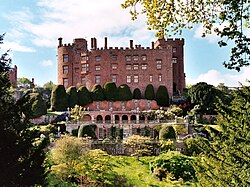Powys Wenwynwyn
Principality of Powys Wenwynwyn Tywysogaeth Powys Wenwynwyn | |||||||||
|---|---|---|---|---|---|---|---|---|---|
| 1160–1283 | |||||||||
Gwenwynwyn ab Owain | |||||||||
• 1216–1286 | Gruffydd ap Gwenwynwyn | ||||||||
| Historical era | Middle Ages | ||||||||
• Established | 1160 | ||||||||
• Abolished by Act of Parliament | 1283 | ||||||||
| |||||||||
| Today part of | Wales | ||||||||
^ Powys Wenwynwyn was often known in English as Upper Powys | |||||||||
Powys Wenwynwyn or Powys Cyfeiliog was a Welsh kingdom which existed during the high Middle Ages. The realm was the southern portion of the former princely state of
Powys Wenwynwyn and Gwynedd became bitter rivals in the years that followed, with the former frequently allying itself with England to further its aims of weakening the latter.
Princes of Powys Wenwynwyn

- 1160–1195 Owain Cyfeiliog married a daughter of Owain Gwynedd and abdicated in 1195.
- 1195–1216 Gwenwynwyn ab Owain
Gwenwynwyn seized the
- 1216–1286 Gruffydd ap Gwenwynwyn
Gruffydd ap Gwenwynwyn spent his youth in England, maintained by King Henry III of England. He did not return to Wales until 1241 after the death of Llywelyn and when he was invested with the lordships of Arwystli, Cyfeiliog, Mawddwy, Caereinion, Ystrad Marchell and Upper Mochnant by Henry III. At some time before this, he married Hawise, daughter of John Le Strange, Lord of Knockin Castle.[1][2]
He transferred his allegiance back to
End of the Principality
Owain ap Gruffydd ap Gwenwynwyn (alias Owen de la Pole) allegedly surrendered the principality of Powys to Edward I at the Parliament held in Shrewsbury in 1283 (Dafydd ap Gruffudd, his rival in Powys Fadog was tried at the same Parliament, he was deposed for fighting on the wrong side and executed for treason against Edward[3]). In return for surrendering the principality, he received it again from the king as a free Baron of England "sub nomine et tenura liberi Baronagii Angliæ, resignando Domino Regi heredibus suis et Coronæ Angliæ nomen et circulum principatus." ("Under the name and tenure of the free baronage of England, by resigning together with his heirs to the Lord the King and the Crown of England the princely name and coronet") The date should be accepted with reserve because Owen did not succeed his father in possession until 1286: it is possible that Owen was acting on behalf of his father, who was by then an old man. From about that time, the former princely family began using the Normanised surname "de la Pole" instead of Welsh patronymics. The name derives from Pool (now called Welshpool), his principal town.
The Lordship of Powys

After the Statute of Rhuddlan in 1284 all of the other old princely titles in Wales also ceased to exist; and henceforth, except the Kingdom of Scotland after 1344, the English Crown did not recognise the title of "prince" or "king" in any native dynasty other than their own. However, the principality continued as a marcher lordship.
The ruling family of Powys survived in the children and remoter descendants of
Marcher Lords of Powys
- Gruffydd ap Gwenwynwyn also known as Gruffydd de la Pole (died 1286 or 1287)
- Owen de la Pole, his son (died 1293) (see also: William de la Pole (of Mawddwy))
- Gruffydd de la Pole, his son (died 1309)
- John Charleton, 1st Baron Cherleton(1268–1353)
- John Charleton, 2nd Baron Cherleton(died 1360)
- John Charleton, 3rd Baron Cherleton(1334 – 13 July 1374)
- John Charleton, 4th Baron Cherleton(1362–1401)
- KG(1371–1421), his brother.
His heiresses were:
- Joan de Cherleton (c. 1400–1425), wife of John Grey, 1st Earl of Tankerville whose son was
- Henry Grey, 2nd Earl of Tankerville whose son was
- Richard Grey, 3rd Earl of Tankerville whose son was
- John Grey, 1st Baron Grey of Powis whose son was
- John Grey, 2nd Baron Grey of Powis (1485–1504) married Margaret, daughter of Edward Sutton, 2nd Baron Dudley, whose son was
- Edward Grey, 3rd Baron Grey of Powis (succeeded to the title as an infant; died 1551).
- Joyce Charleton of Cherleton, wife of John Tiptoft, 1st Baron Tiptoft, whose daughter, also Joyce, carried the Tiptoft portion of the Cherleton inheritance to the family of her husband Sir Edmund Sutton of Dudley, which their grandson John Sutton, 3rd Baron Dudley, "Lord Quondam", sold to his nephew, the 3rd (and last) Baron Grey of Powis, circa 1538.
Beyond the Marcher Lordship
The
- Edward Grey, 3rd Baron Grey of Powis (died 1551).
- Edward Grey of London, his illegitimate son, sold the lordship (no longer a marcher lordship) to his kinsman Sir Edward Herbert in 1587.[4]
- Sir Edward Herbert, a blood relative of both descendant branches of the Cherleton Barony.
- Baron Powisin 1629.
The estate then descended to successive holders of the titles Baron Powis, Marquess of Powis, and Earl of Powis.[5]
References
- ^ "GRUFFYDD ap GWENWYNWYN". Dictionary of Welsh Biography. National Library of Wales.
- ^ The National Archives. Ref: SC 8/2/75. Petitioners: Thomas Hastang (Hastings) and Maud Hastings wife of Thomas Hastings, widow of John Lestrange. Addressees: King and council. Date: [1315].
- ^ "Plantaganet Shropshire". Shropshire History.
- ^ "POWIS, Lords of Grey". Dictionary of Welsh Biography. National Library of Wales.
- ^ "HERBERT family, (earls of POWIS)". Dictionary of Welsh Biography. National Library of Wales.


